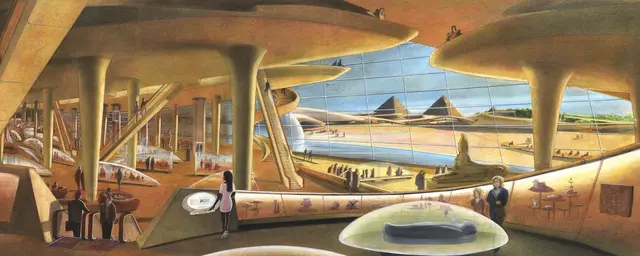On a vast area of cliffy land some two kilometers in the north of the Great Pyramids of Giza near the capital Cairo, hundreds of workers and engineers have been racing against time at the construction site of the Grand Egyptian Museum (GEM) for the soft opening of the region's largest museum in early 2018.
"The GEM can accommodate 100,000 artifacts: 50,000 will be in constant display and another 50,000 will be stored in modern storehouses. Among the 50,000 in future display, there will be 30,000 that have never been displayed before," said Tarek Tawfik, GEM General Director, noting the grand opening of the museum will be before the end of 2022.
Tawfik, the general supervisor of the massive project, said that ancient Egyptian King Tutankhamun will be "the GEM star," for all his discovered heritage - more than 5,000 pieces - will be displayed in the GEM soft opening, noting that only one-third of them used to be showcased since their discovery in 1922.
The total area of the grand museum, initiated in 2001, is about half a million square kilometers, one-third of which will be premises, the area of museum display will be about 45,000 square meters while the rest will be used for landscape and other purposes.
The partial inauguration in early 2018 will be on an area of 15,000 square meters, which is still larger than the current display area in the Egyptian Museum in Tahrir.
"More than 4,000 labors work hard to finish the project in time. Work here is almost nonstop to prepare the construction part for soft opening in early 2018. The following step is to move the artifacts from the Conservation Center to the display halls through a tunnel connecting the center with the museum," Islam Mostafa, member of the technical office of GEM project, told Xinhua at the construction site.
The GEM buildings are planned to include a 1,000-seat international conference hall to prompte the museum's activities and also bring an additional income to the GEM.
It will also include a museum for children to increase cultural and archeological awareness of coming generations, as well as a commercial zone and a mall containing bazaars, restaurants and various stores.
Japan assisted Egypt with a facilitated loan of 300 million U.S. dollars to start the construction and another loan of about 450 million has been negotiated to finish it as planned. The GEM director said Egypt will pay them back so that it will be a purely Egyptian national project.
When it started in 2010, the Conservation Center was first established at the GEM to receive the artifacts from all over the country to be restored, maintained and prepared for display.
Since the center is opened, it received about 40,000 artifacts, 75 percent of which has already been restored and awaiting display.
They include over 2,500 artifacts belonging to young King Tut whose tomb was discovered western Luxor by British archeologists Howard Carter and George Herbert in 1922.
At the organic laboratory of the Conservation Center, the lab chief Eman Shalabi showed Xinhua reporters King Tut's pair of sandals after conservation in a special box on a table with an old documentary picture showing to their damaged condition when they first found in the tomb.
"We received them from the storehouse of Tahrir museum in 2012 and they were completely rigged. We used software to imagine the places of each piece of the sandals that are made of leather, papyrus and surrounding golden strings. We fitted the parts we're quite certain about and straightened the golden strings," Shalabi told Xinhua at the lab, noting all the material used in conservation is reversible and can easily be dismantled.
At the nearby wood lab, conservators have been working on some ancient wooden statues, coffins, sticks, boxes and others, after finishing restoration of around 90 percent of the 935 pieces they received.
"In excavation in general, we're governed by international standards and criteria, the first of which is to maintain the originality of the artifact including its material, design, shape and environment. We also observe a minimum intervention to maintain the stability of the artifact without any trace of conservation or maintenance," said Mehat Abdullah, head of the Conservation Center's wood lab.
On the far left side of the center's long corridor lies the floor of the lab dealing with heavy artifacts was full of ancient antiquities and the spacious room had a large ceiling crane that makes it easy to carry, move, assemble or separate the heavy objects.
"We received here more than 246 heavy artifacts and we finished about 90 percent of them and they are ready for display," said the lab chief Hossam Rashed, boasting that his department invented a hydraulic clamp-like base that can carry and assemble pieces of broken artifacts without using adhesives or supporters.
The soft opening in early 2018 will feature in the forefront some 100 huge antiquities, such as standing statues of pharaohs including King Ramses II, while the exhibition rooms will display King Tut's complete set of over 5,000 ancient pieces.
 简体中文
简体中文

